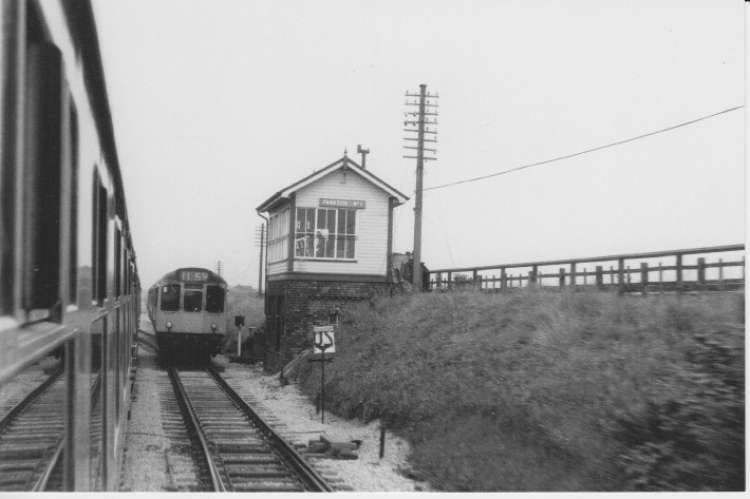
8D ASSOCIATION
The 8D Association is dedicated to promoting the history of the railways of South Lancashire, Merseyside and North Cheshire.
A study of the signal boxes from Liverpool Lime Street to Parkside Junction.
There have been over 70 operational signal boxes along this historic section of line. They are listed below along with certain Ground Frames of interest.
Liverpool Lime Street.
The Minutes of the LNWR, from 16 May 1867, reveal that the Directors authorised the construction of a signalmans hut to be erected ‘at once, where it will be permanently required once the station alterations are finished’. Simply named Lime Street it was located 115 yards west of Lime Street No1. The box was re-named Lime Street No2 during 1877 when No1 box opened. Further alterations to the layout at the station were completed in September 1879 with No1 controlling all station movements. No2 box was closed in September 1879, probably around the 27th, this being in the Directors Minutes for October 1879. The second box to open was an LNWR type 4 wooden top on a tall brick base box in 1877 it stood at the station throat where the cutting from Edge Hill fanned out. Records show that the box and layout were inspected on 27 September 1879 and that it was equipped with an LNWR 105 lever Tumbler Frame. The box was extended in 1885, as the station expanded, and the lever frame had an additional 30 levers added. Further expansion took place in 1907 with an extension being constructed and the frame size increased 155 levers. The box would be abolished on 25th January 1948 in conjunction with the opening of the present day box. This new box was an LM & SR ARP type 13 box with 14 inch thick solid brick walls with a 12 inch thick reinforced concrete roof. It was equipped with a Westinghouse Brake and Signal Company L style miniature frame housing 95 levers, 31 for points, 58 for signals and 6 spare. During 2019, the signal box was taken out of commission and replaced by the centralise Manchester Railway Operating Centre.
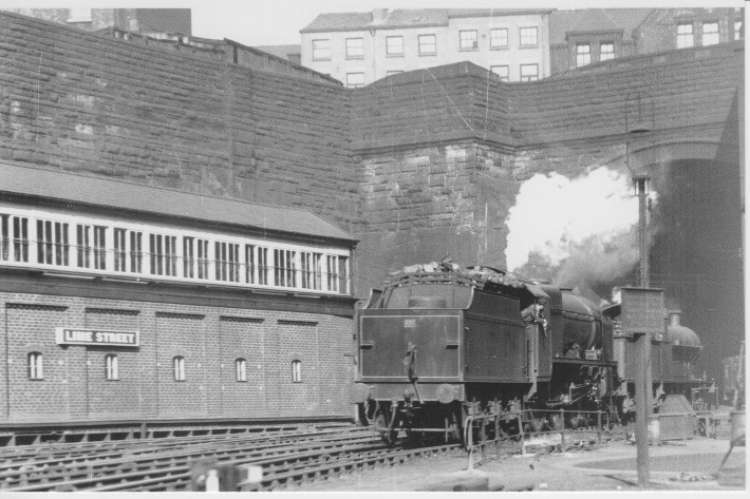


(To view more of the James Mackenzie collection click here )
Edge Hill No1
Opened in May 1885 and Minuted in June No1 box was located immediately west of Edge Hill station within the cutting down towards Lime Street. It was an LNWR type 4 box top mounted on a metal gantry standing above Up line 1. It was equipped with a 24 lever LNWR frame of the special SK449 design for overhead boxes with no locking room. The box was abolished on 5 July 1947 with its layout being transferred to the new Edge Hill No2 box.

Edge Hill Passenger Station No1
The first box here was opened by 3 July 1866 and was located at the west end of Edge Hill station, the name of the box is not recorded it had closed by 1874. A second box had opened by 1874 with a location of immediately west of Edge Hill station which appears in the LNWR Minutes in June 1885 as being closed in the previous May. The design and type of both boxes was not recorded.
Edge Hill Passenger Station
Located at the east end of Edge Hill station and open by 3 July 1866 the design and lever frame have not been recorded. The box was closed by 1872 with control of the layout being transferred to a new No3 box at Lime Street Junction. It is thought likely that the box name did contain the suffix No2.
Waterloo Tunnel Mouth
Adjacent to the number 1 platform at Edge Hill and controlling the tunnel from which it takes its name and the Grid lines up to the Grid Iron. The box was an LNWR type 4 which opened in June 1895 it was equipped with an LNWR 25 lever tumbler frame. The box was out of use by 19th December 1973 and abolished on 1st September 1974.
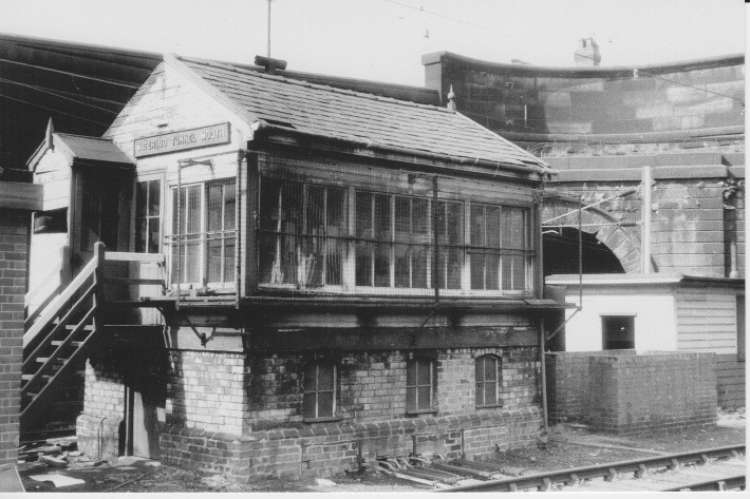
Edge Hill No16 / Picton Road Junction
There have been 2 boxes at this location the first being open by 16 June 1875 equipped with a 25 lever frame it was abolished in November 1902. The second to be sited here was opened in November 1902 and was an LNWR type 4 wooden top on a low brick base. The box was equipped with an LNWR 36 lever tumbler frame. The box survived nearly 80 years and was abolished on 24 May 1982.
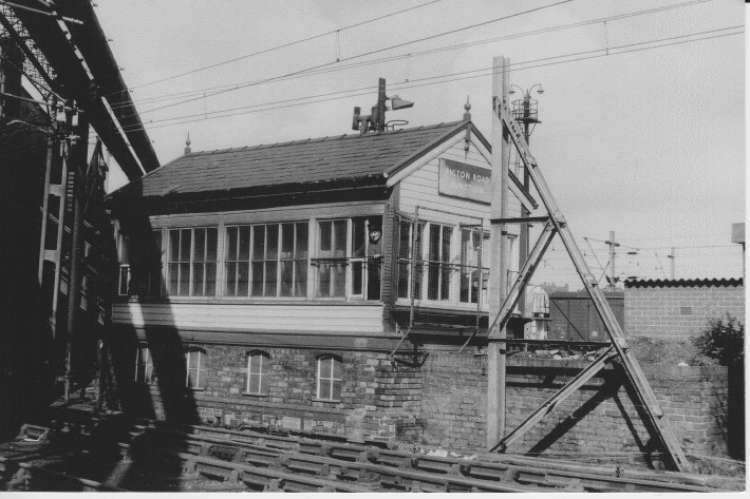
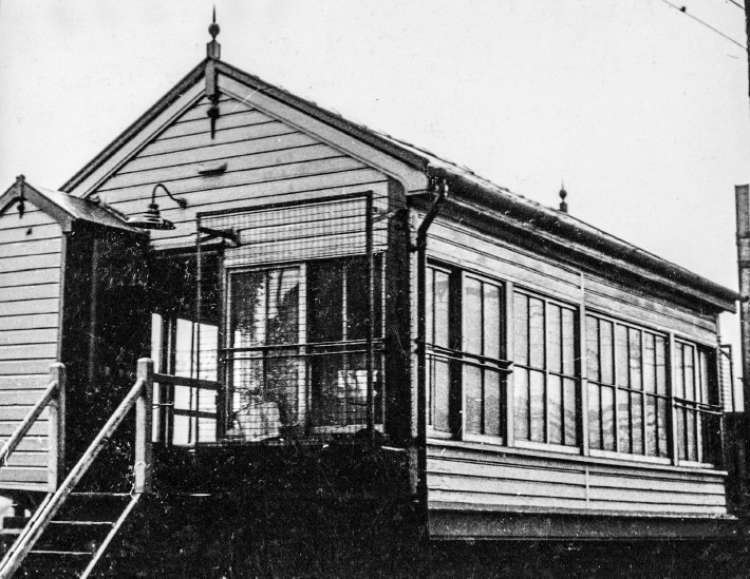
Edge Hill Lime Street Junction / Edge Hill No3
Signals were located, at this important junction, by 1861 and by 1864 a box had been constructed on the up side, east of Edge Hill station. The box was abolished during 1872 with the opening of Edge Hill No3 Lime Street Junction. The 1872 box was a Saxby & Farmer design and frame with 41 working levers. It was located close to the original Lime street Junction box and was replaced in August 1887 by Edge Hill No2.
Edge Hill No3 / No2
The first box to open at this location was open in August 1887 and was an LNWR type 4 Oversailing box with a wooden top and a narrow brick base. Located on the Down side opposite the Lime Street Junction No3 box, which it replaced. By 15 October 1887 the box had been officially re-named Edge Hill No2. It was equipped with an LNWR 90 lever tumbler frame. This box was abolished on 5 July 1947 in conjunction with the opening of a new No2 box. The new No2 box opened on the same date as the previous ones abolition and was an LM & SR ARP Type 13 box with solid brick walls and a flat reinforced concrete roof with the frame size not being recorded. The box would be abolished on 28 August 1961 with the opening of the Edge Hill Power Box.
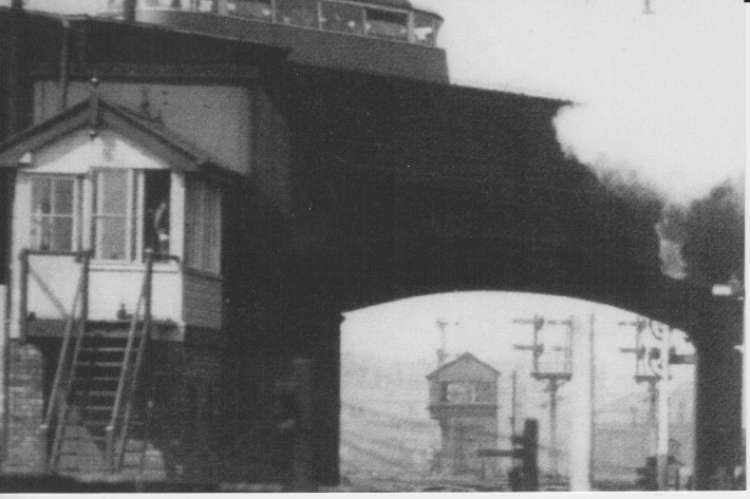

Edge Hill No12
This was the third or fourth box to bear this number, the first two boxes being at Picho Lane. The box, shown below, was the final Edge Hill No12 and was opened in 1934/35. It was an LNWR type 5 with a brick base and a wooden top, which was possible second hand. The box contained an LNWR Tappet frame with 15 levers. The box was abolished on 8 December 1957 with its functions transferring to Edge Hill No2.
Edge Hill No11 / Engine Shed Junction
The original No11, Engine Shed Junction box was located on the Wavertree Curve and was opened around 1865 and closed during 1887 being replaced with a second box bearing the same name. The design or type of either box was not recorded. The No11 box, that is shown below, was opened on 7 August 1948 and was located on the ‘new’ circular goods line. The box was an LNWR type 4 wooden top on a brick base it was equipped with an LNWR 30 lever tumbler frame. The box was abolished with the closure of the circular goods lines on 25 June 1983.

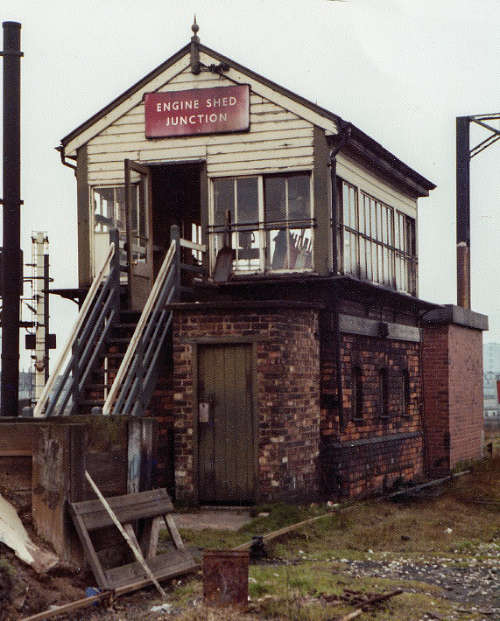
Edge Hill Power Box
With the electrification from Weaver Junction to Liverpool Lime Street many of the traditional signal boxes in the Edge Hill area were to close. The were replaced on 28th August 1961 with the opening of the new power box. The new box was classified as a British Railways London Midland Region Power Signal Box. It has a steel frame with concrete cladding equipped with an NX Panel from new which was replaced in 1985. The new box took over the work of 3 manual signal boxes and remains open today.
Edge Hill No14
This LNWR type 4 box opened during April 1887 with a 25 lever frame. It was initially opened as a Block Post controlling both the Waterloo line, the Grid line and the two separate junctions between those two lines. It ceased to control both junctions and the Waterloo line and became a Non-Block Post when the Waterloo Tunnel Mouth box opened in 1895 and took over a large proportion of the layout. By 1925 the box structure had been removed and, it is entirely possible that, it was replaced by a Ground Frame as it was still listed in the 1937 Sectional Appendix.
Edge Hill No13 / Exhibition Junction
The first box at this location was opened in May 1886 and was an LNWR type 4 equipped with an LNWR tumbler frame, 35 working levers and 5 spare, the box would be abolished during 1928. The second box to open here did so in 1928 presumably as the previous one closed. The new box was a Midland type 4d wooden top on a brick base initially it was equipped with an REC 105 lever frame but this was replaced with a BR LMR 100 lever frame. The box would be abolished on 25th April 1976.
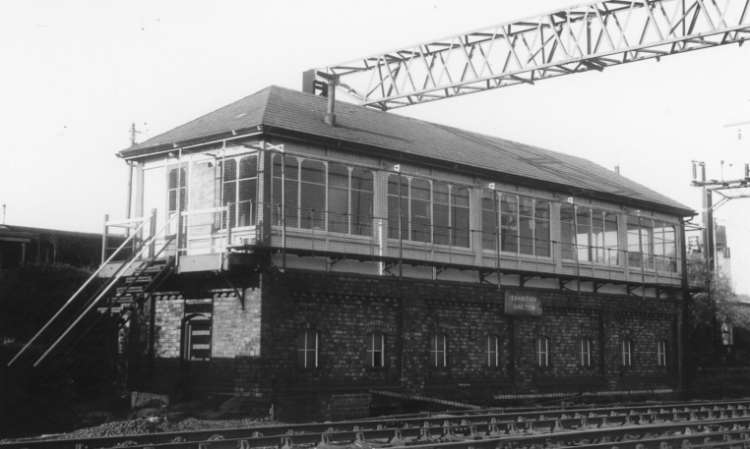
Exhibition Station
Opened by 9 May 1886, for one week, to control movements in and out of the temporary Exhibition Station. The box was basically a hut but did contain an 18 lever frame, it closed on 16 May 1886.
Edge Hill No4 / Viaduct Junction
The first Edge Hill No 4 was open by 16 June 1875 and was situated on the Up side adjacent to the goods lines close to Picton Road. Details of the box have not been recorded although it is known that it closed during 1887 and the No4 name was re-allocated to the new Viaduct Junction box in the same year. No4 Viaduct Junction opened during March 1887, minuted in April 1887, and was an LNWR type 4 of brick to floor construction with a wooden top. It contained an LNWR 30 lever Tumbler frame and controlled the Down Main South line, the Waterloo, Wapping, a single Grid Iron line and a connection to Edge Hill shed. The box ceased to signal the Down Main South line on 7 March 1957 but continued to signal the Waterloo and Wapping lines. The box was abolished on 13 April 1969.
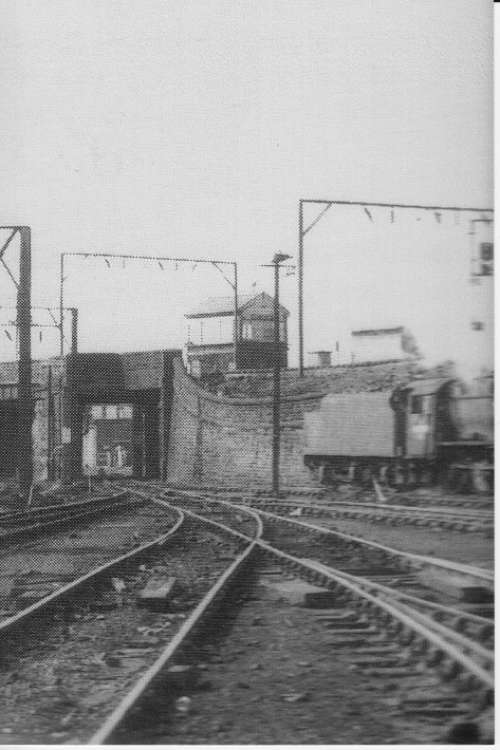
Edge Hill No 4 Signal Box near to the former coal loading point.
Photographer unknown.
Edge Hill No5
The first No5 box was open by 16 June 1875 and was located on the Up side on the goods lines east of No4 Viaduct Junction. It appears to have had connections from the main lines to the goods lines. It was closed during 1887 and the No5 name was re-allocated to the existing Edge Hill No8 box when that box took over control of the main lines and the Bootle Branch.
Garston Junction / Edge Hill No6 Main Junction
A Saxby & Farmer design box was opened here during 1864 in conjunction with the opening of the ‘new’ line to Garston. From 1866 it also controlled the junction with the ‘new’ Bootle Branch. The box was replaced during December 1871 as work progressed on the widening of the line to Broad Green. Again a Saxby & Farmer design box was constructed, the company were the signalling engineers for the project, by December 1876 it was known to have contained 60 working levers. The box was closed during January 1882 with the opening of Edge Hill No6 immediately east.
Edge Hill No6 / No3
A tall LNWR type 4 brick to floor, with wooden top, box opened here in January 1882 and replaced the Garston Junction/No6 box. The box was equipped with an LNWR 90 lever Tumbler frame and controlled both junctions towards Bootle and London. The box was re-named No3 during the major re-signalling works of 1886/7 and would close on 28 January 1961 with the opening of Edge Hill Power Box.

Downhill Sidings
Opened during 1876 and located at the west end of Downhill Carriage Sidings and situated diagonally opposite Edge Hill No6 (No3 from 1887). Design and frame size have not been recorded and the box closed on 29 December 1929.
Edge Hill No7
Open by 1875 and located west of Edge Hill No8 and situated on the Up side on the goods lines leading to the commencement of the Bootle Branch. The box controlled connections to the sidings with no further information recorded. The second box at this location was inspected on 28 February 1888 but it is probable that the box had opened previous to this. It was located in roughly the same position as the previous No7, which it replaced. The box was later listed as a hut containing 12 working levers and had been abolished by 1937.
Edge Hill No8 / No5
A box had been opened at this location by 1874 and was located on the Up side of the Bootle Branch, east of No7 box and west of Picho Lane bridge. It controlled connections to and from additional goods lines that led onto the Bootle Branch. The box was replaced by a new structure bearing the same name during April 1881. An LNWR type 4 box of brick to floor construction with a wooden top was constructed adjacent to the box which it replaced and was equipped with a 45 lever tumbler frame. During 1887 the box became responsible for control of the Up & Down north main lines and was subsequently re-named Edge Hill No5. The box was abolished on 28 August 1961 with the opening of Edge Hill Power Box.
Edge Hill No9 GN Cattle Sidings
Edge Hill No10 Engine Shed Sidings
Edge Hill No12 Picho Lane
The box at this location opened in conjunction with the widening of the railway through to Huyton in 1871 and was originally known as Edge Hill Junction. It was located on the Down side, east of Picho Lane bridge and diagonally opposite No8 box. It was a Saxby & Farmer design box and frame with 35 working levers and controlled the main lines and connections to the Bootle Branch. The box was abolished during April 1881.
Pighue Lane Junction
Controlling the Bootle branch line which ran west to east from Edge Hill was this LNWR type 4 wooden top on a brick base box. The box which opened during May 1886 was equipped with an LNWR 20 lever tumbler frame. It was abolished on 15th February 1976.


Olive Mount Junction
An LNWR type 4 box with a wooden top on a tall brick base opened in the cutting here in July 1883 equipped with a 36 lever LNWR tumbler frame. The box had a long life and was deemed surplus when the eastern junction into the docks was closed and lifted. The box was abolished on 16th May 1998 and demolished with the branch to the docks has since been re-laid and is once again operational.
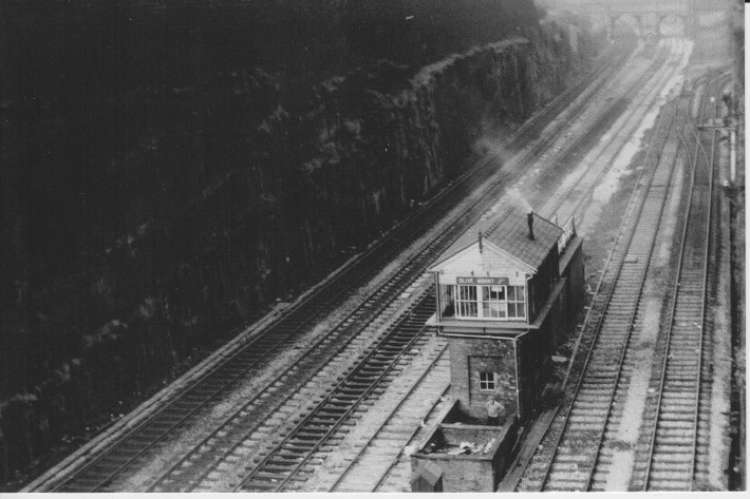
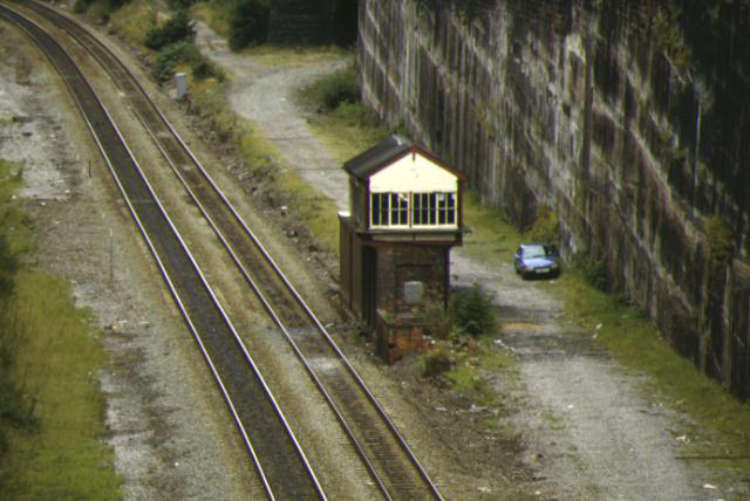
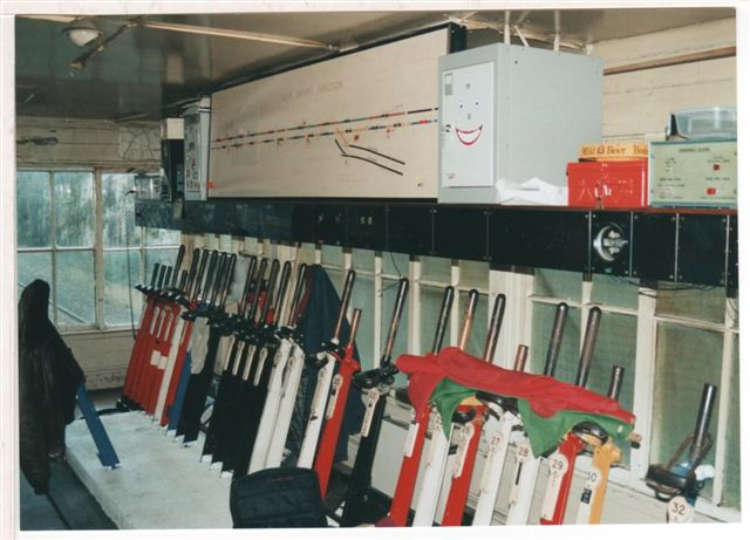
(To view more of the James Mackenzie collection click here ).
Broadgreen
The first box to open at this location was opened in December 1871 and was abolished in October 1887. This closure was necessitated with the quadrupling of the track from Olive Mount to the junction with the line to Wigan at the east of Huyton station. The new box was an LNWR type 4 with a wooden top on a brick base built on the station platform and opened in October 1887 it was equipped with an LNWR 19 lever tumbler frame which was later extended to 29 levers. Due to the construction of the M62 motorway the station was rebuilt in 1970 and reduced from 4 platform faces to 2. This sadly led to the box being abolished on 13th December 1970.

The LNWR platform mounted type 4 box at Broad Green. 14th August 1969 as D5202 passes by with an Inspection Saloon.
Copyright: J.A. Sommerfield

Roby
Details of the box at this location are sketchy the only detail we have is that a box opened here in December 1871. The type, frame and closure date are unknown.
Huyton Station
The first box to open at this location was open by 1879 and was clearly not in the way when the line was quadrupled in 1887 as it was only abolished in March 1899. The second box to open here opened in March 1899 and was an LNWR type 4 wooden top on a tall brick base situated to the west of the eastbound island platform in between the running lines. It was equipped with an LNWR 36 lever tumbler frame. The box was abolished on 4th July 2014 and demolished on the 5th as part of the electrification of the route from Liverpool to Manchester after 115 years of operation.
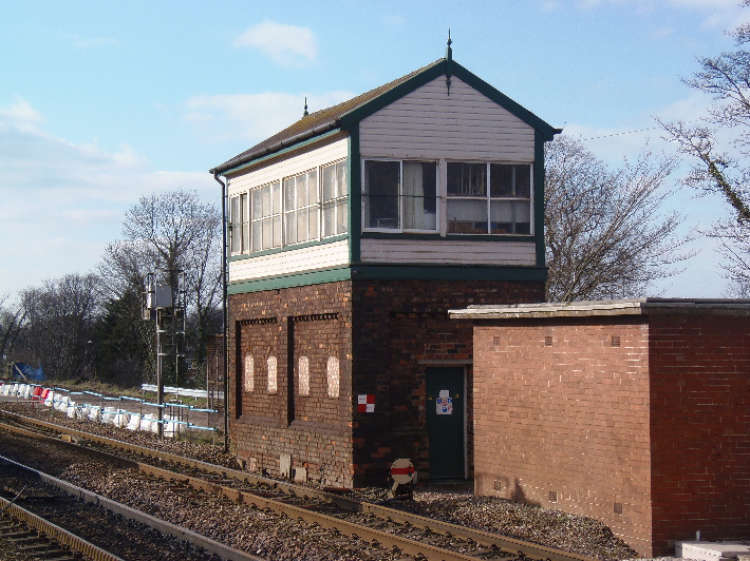
Huyton Junction
The first box to open at this location was in December 1871 and this box would be replaced by an LNWR type 4 opened here during November 1880. The type 4 was equipped with an LNWR 30 lever tumbler frame which had 18 working levers and 12 spares. The second was abolished during October 1896 being replaced by another LNWR type 4 which was equipped with an 18 lever LNWR tumbler frame. The third box was abolished during 1939.
Huyton Quarry
The first box to be opened here opened in 1872 the box was abolished in November 1880 with the opening of a new one. The 1880 box was an LNWR type 4 wooden top on a brick base box equipped with a 36 lever LNWR tumbler frame. The box was reduced to a shunt frame on 25th November 1973 before being abolished on 4th December 1976.
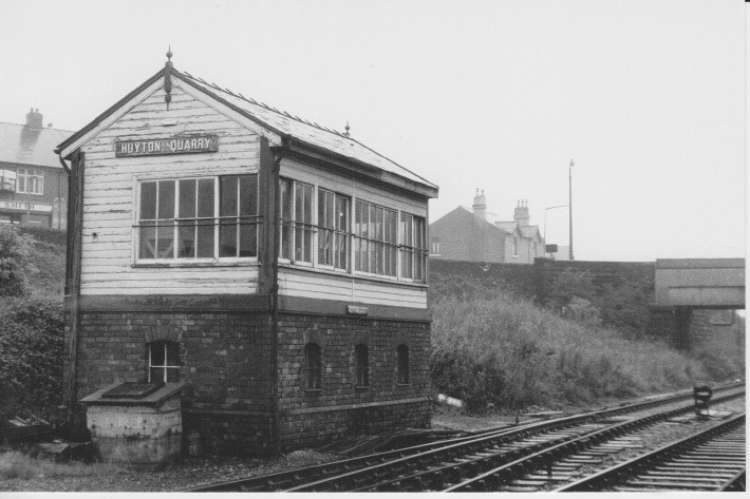
Lancaster Siding West / Lancaster No2
Opened during 1874 and inspected on 4 April of the same year. The box controlled the west connection, from the main line, to J Lancaster’s Colliery (latterly known as Prescot Colliery). The box was abolished during January 1916.
Lancaster Siding West / Lancaster No1
Opened during 1874 and inspected on 4 April of the same year. The box controlled the west connection, from the main line, to J Lancaster’s Colliery (latterly known as Prescot Colliery). The box was abolished during January 1912.
Top of Whiston
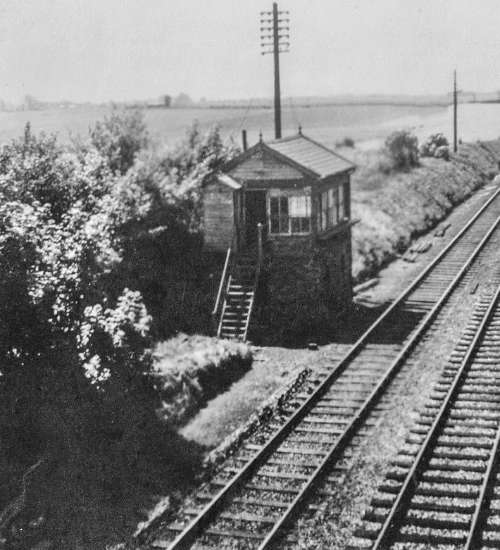
Whiston Bank
Rainhill
The box here was opened in 1896 and is an LNWR type 4 wooden top box on a brick base. It was equipped with an LNWR 25 lever tumbler frame. The box controlled not only the plain line through the station but the connections to Lea Green colliery which entailed crossovers to the up and down goods lines which ran from a point east of the box through to the colliery. Both lines were lifted in the late 1960’s/early 1970’s and the box then just controlled plain track through the station. On 17th September 1972 Rainhill became a fringe box of Warrington Bank Quay with the vast majority of the boxes east closing on that day. The box was abolished on 26th March 2007 and is still standing although now in need of some maintenance.
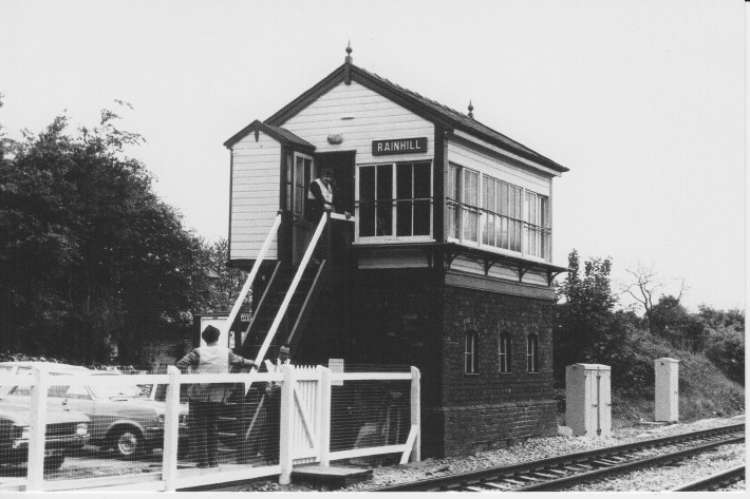
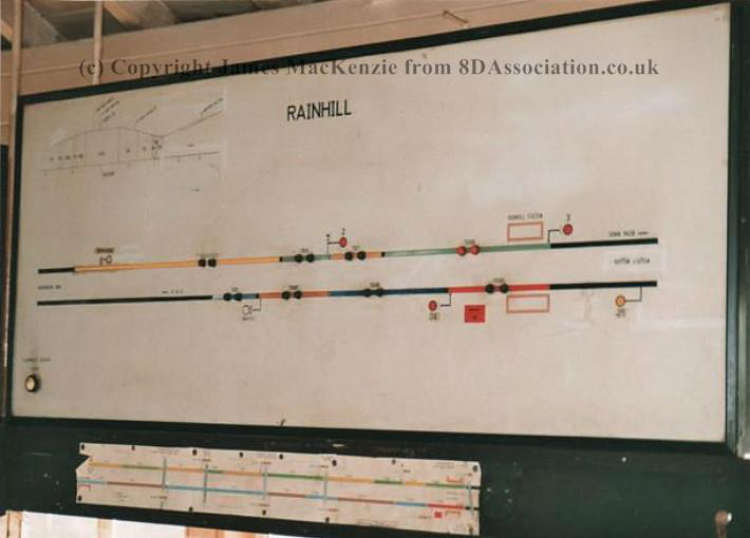
(To see more of the James Mackenzie collection click here ).

Lea Green
The first box to open here was opened in November 1875 and was abolished in June 1933. The box was replaced in 1933 by and LMSR type 11 equipped with a 30 lever frame this box would be abolished on 25th June 1967.

Sutton Bank
St Helens Junction / No1
The first box at this location was opened in 1871 and was abolished in 1885 with the opening of No1 box. The new box was an LNWR type 4 wooden top on a brick base it was equipped with an LNWR 64 lever tumbler frame. It was abolished on 17th September 1972 when the Warrington Power Signal Box took over signalling for the area.
Bold Colliery
There have been several boxes and ground frames for the large sidings associated with the colliery and power station at Bold.
Bold BEA Frame
Opened on 3rd April 1955 this was an interesting box it was essentially a ground frame which had a BR LM type 15 ground level wooden construction box built around it. It was equipped with a BR LMR 15 lever frame. It was abolished on 17th September 1972 and replaced on the 18th September 1972 with an open ground frame consisting of 3 levers in an SK80 frame. This frame was out of use on 23rd November 1987 and officially abolished on 26th February 1989.

Bold Colliery Ground Frame
Bold Colliery Sidings
The first box to open here did so during July 1889 and was equipped with a 12 lever frame it closed on 3rd July 1955 with the opening of a second box. The second box was a BR LMR type 15 all wooden construction equipped with a BR LMR 45 lever frame. This box would be abolished on 17th September 1972 as Warrington PSB took over signalling of the main lines and the ground frames took over the sidings.

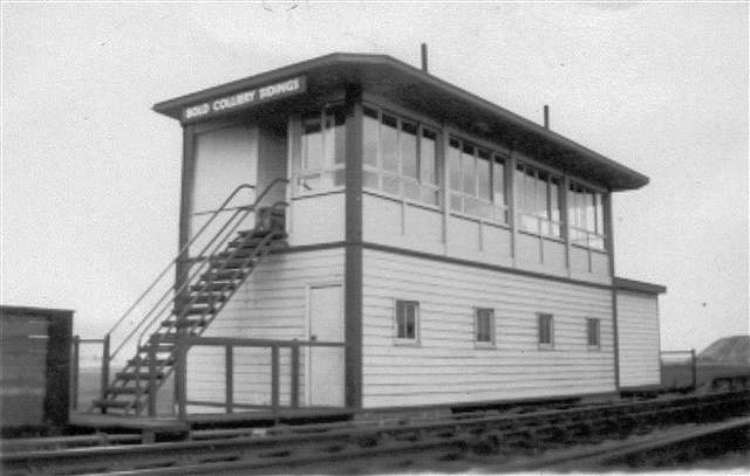
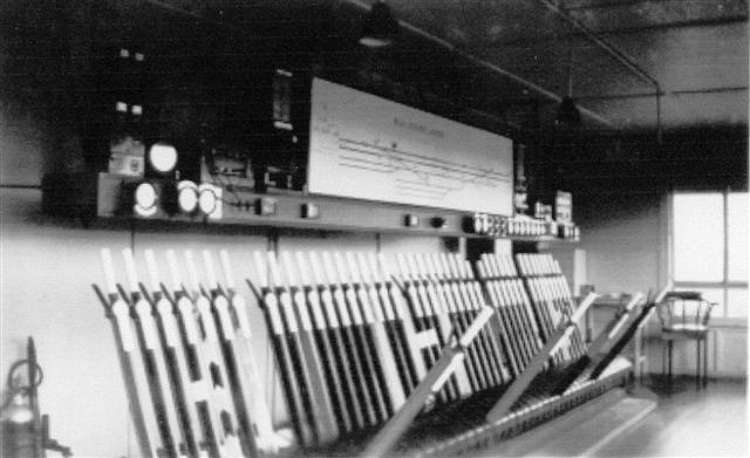
(To view more of the James Mackenzie collection click here ).
Parr Moss Colliery
Collins Green
The first box to open here did so by August 1879 and with the opening of a new box was abolished in October 1883. The second box was equipped with a 17 lever frame and was abolished on 15th August 1965.
Viaduct Cabin / Earlestown No5
The first box at this location was opened by 1880 and from 1898 was equipped with an LNWR 25 lever tumbler frame the box would be abolished in 1914. The second box opened with abolition of the first and was an LNWR type 5 wooden top on a brick base. It was originally equipped with an LNWR 30 lever tappet frame which in 1931 was extended to 33 levers. The box would close on 17th September 1972 with the opening of the Warrington PSB.
Liverpool Junction / Earlestown No4
The first box to open here was opened in 1873 originally called Liverpool Junction the box was renamed Earlestown No4 by 1889. It was a Saxby and Farmer type 6 box of all brick construction. Initially it was equipped with a Saxby and Farmer 24 lever frame which was replaced in 1890 with a new LNWT 28 lever tumbler frame. The original box was abolished in 1913 with the opening of an LNWR type 5 wooden top on a brick base box. The new box was equipped with an LNWR 40 lever tappet frame this box too would be closed on 17th September 1972 with the opening of the Warrington PSB.
Earlestown Station
Earlestown No3 Haydock Crossing
Controlling movements across the flat crossing to and from Haydock colliery at the east end of the Liverpool and Manchester platforms at Earlestown station. The box which opened in 1910 was an LNWR built wooden hut it was equipped with an LNWR KI 12 lever frame. When the Haydock branch closed the box was surplus to requirements and was abolished on 17th February 1968.

Earlestown No2
The box at this location opened during 1910 as a direct replacement for Manchester Junction box. The box was an LNWR type 5 wooden top an a brick base equipped with an LNWR 35 lever tappet frame.
Manchester Junction
The box at this location opened in 1873 and was a Saxby and Farmer type 6 box. It was originally equipped with a Saxby and Farmer 19 lever frame but was later reequipped with an LNWR tumbler frame. The box ws abolished on 17th September 1972 with the opening of the Warrington PSB.
Newton Bridge / Newton Le Willows
The first box to open at this location did so during 1864 and was abolished in February 1877. The second box opened in conjunction with the firsts closure in February and was an LNWR type 4 box equipped with an LNWR tumbler frame. The box was abolished on 17th December 1961. The final box at this location opened on 17th December 1961 and was a BR LMR type 15 equipped with a BR LMR 65 lever frame.
Stones Siding
Stones Crossing
The diminutive LNWR crossing box, seen to the right of the locomotive in the picture below, opened during February 1893 and was located on the Down side of the level crossing. It was listed as an LNWR Signal Hut and was equipped with an LNWR SK80 type, 2 lever frame. The box was abolished on 17 June 1959.

Liverpool Junction
Parkside No2
Replacing Stones Siding and Liverpool Junction box and opened during 1893 this box was an LNWR type 4 wooden top on a brick base equipped with an LNWR 14 lever tumbler frame. The box was abolished on 17th December 1961 with the opening of the new box at Newton Le Willows.
Preston Junction
Parkside No1
The box at this location opened in January 1906 and was an LNWR type 5 wooden top on a brick base. It was equipped with an LNWR 30 lever tumbler frame. It was abolished on 17th September 1972 with the opening of the Warrington PSB. A ground frame was installed here called Parkside Emergency Merging Ground Frame from the date of the abolition of No1 box it consisted of an open SK80 frame with 3 levers . The ground frame was taken out of use on 19th April 2009 and abolished on 5th May 2009.
